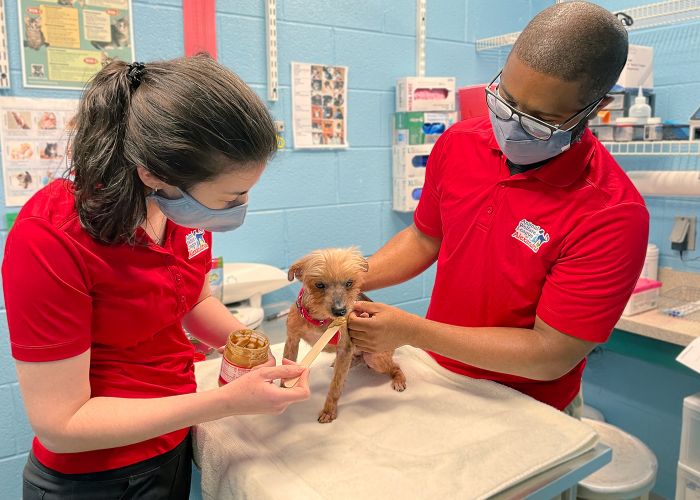Your board ... and how to nail it
Build it, and it will help build you

All too often, rescue groups find themselves scrounging for funds for an animal in need of significant vet care, struggling to find enough volunteers to maintain all their programs, or puzzling through setting the organization’s policy on taking in owner-surrendered pets. They daydream, “If only we had a committee to deal with these broad policy issues and long-term fundraising goals, our staff and volunteers could focus on the day-to-day issues.”
As it happens, you already have such a group—or you should. Your board of directors, when serving its intended purpose, is your organization’s core tool when it comes to strategy, long-term planning, fundraising, and much more.
There are many different types of boards, from working boards with a high level of engagement to boards that are simply responsible for policy approval. Before you begin, think about what type of board you need along with what you want it to accomplish. Any rescue group that’s grown much beyond one or two people taking in the occasional pet, that seeks to make a real impact on the lives of people and animals in its community, should be taking steps toward a more professional structure.
“When you start to grow beyond the ‘Mom & Pop,’ 20-30 animals [operation], then you kind of have to have an infrastructure to support your organization,” says Barbara Kertess, a member of the board of directors and adoption counselor for PetConnect Rescue in Potomac, Md. That means developing written guidelines and having a communication strategy, an understanding of your finances, and the ability to demonstrate those finances to potential donors. “The bigger you get, the more complex the operation becomes, and the more you need established processes in place to support it. … Otherwise you’re constantly trying to reinvent the wheel.” Creating a board of directors is a good first step toward these goals, and can be hugely helpful to your rescue’s lifesaving work.
Why Rescues Need Boards
According to David Renz, director of the Midwest Center for Nonprofit Leadership at the University of Missouri-Kansas City, a board of directors is essentially a core group of volunteers who bring a shared cause forward, by determining the mission and vision for an organization and then implementing it.Renz argues there are three reasons that every organization should have a board. The first: Every organization structured as a corporation is required by law to have a board of directors that is legally accountable for the organization’s work.

The second is for strategic leadership and planning. “The key function boards should play is to be a strong link between the organization and its work and the community it exists to serve,” according to Renz. For example, rescue board members should represent the organization at neighborhood fairs and events and be prepared to speak on its behalf.
The third reason, he says, is to go beyond the “setting strategic direction” issue and actually help the organization grow and develop. It’s the board’s responsibility to provide support on issues from fundraising to bringing additional resources such as an intelligence source or connections, to serving as a sounding board for staff.
Renz has an easy mnemonic for remembering what boards are responsible for: “The 5 Ws,” which are Work (the board is there to work), Wealth (ensure the organization has the funds it needs to fulfill its mission), Wisdom (ensure the organization has the information and brain power it needs), Wallop (provide power, clout, connections), and finally Wit (work with each other with a sense of perspective and humor).
What A Board Should Do for You
Boards define an organization’s mission and provide the tools to ensure that the organization is able to fulfill its goals. Dreaming up creative ways to find more volunteers, raising funds to provide vet care for your animals, finding new ways to engage the community—these are all responsibilities of your board and not your staff, who are the people responsible for carrying out the day-to-day functions.
Kertess says the board has to be involved in the organization’s strategic functions, such as the mission statement, operational planning, budgeting, and funding. The board, she adds, needs to focus on what the organization hopes to achieve, develop the plan for achieving it, and then help to ensure that there are processes in place to support it.
Traditional board obligations are varied, but according to Renz, they can be boiled down to the following:
- Determine the mission and vision of the organization by laying out a mission statement, filing for incorporation with the state, and obtaining tax-exempt status.
- Provide oversight by being responsible for all policies and procedures of the organization. For example, the board sets intake policy, adoption criteria, and euthanasia policy, and provides permission to spend funds. These policies guide your executive director in making the day-to-day decisions.
- Determine who is going to be the executive director (ED) of the organization. While this may seem obvious, many rescue groups have this the other way around by first choosing the ED and then finding the board. It’s actually the board’s responsibility to determine who this person should be.

Kari Berg, board chair of Secondhand Hounds in Minnetonka, Minn., notes that it’s best not to have your ED (or any paid staff member) serve as board president or chair. As the group that may be setting salaries and reviewing performance, it makes for a very tricky situation if someone on the board is in charge of both sides of that process.
- Provide support and oversight for the ED. Christine Stickley, board president of Black Dog Animal Rescue in Cheyenne, Wyo., finds that the best way for a board to support its executive director is to assess the weaknesses of an organization and bring on board members to fill in those gaps. For example, if your organization is doing a great job on adoptions but you notice that you’re spending more on vet care than you can afford, it’s time to bring in someone knowledgeable on fundraising or event planning.
And according to Stickley, it’s important to build trust between the board and the executive director so that the ED has more freedom to run the organization without having to ask the board for approval of every decision.
Berg finds that providing a budget makes it easier to provide support. Secondhand Hounds has a budget that’s approved by the board, and the ED can make any of those pre-approved expenditures; anything outside of that budget requires special consent by the board.
- Ensure that strategic and operations planning are getting accomplished.Strategic planning is conducted by the board, while program planning or operations planning is done by staff.
One of the challenges that frequently arises in small and volunteer initiatives, says Renz, is that people are so motivated to address the immediate challenges that they don’t back up to a more strategic level and think about the bigger picture, and about how they’re going to have a longer-term impact. Because organizations never have enough resources to do everything they’d like to do to fulfill their mission, it’s critical for a board to think strategically about the key goals to achieve the biggest impact with limited resources.
- Ensure that the organization has the resources to accomplish its goals. If the organization doesn’t have enough money, it’s the board’s responsibility to either obtain additional resources or scale back plans. This is more than financial; the board should also ensure there are enough volunteers, or work on obtaining political clout to change local or state policies that may not be animal-friendly.
PetConnect Rescue, Kertess says, has an advisory board made up of core volunteers that meets quarterly. The advisory board acts as an intermediary between the board of directors and volunteers, helping discuss any issues or concerns, provide input on any change in policies, and, in general, ensure that the communication works well throughout the organization.
- Ensure that the organization’s resources are used effectively. It’s the board’s obligation to think about the organization’s programs and evaluate their effectiveness against their stated mission.The board, Stickley notes, is the rational, business-minded group that says “This plan isn’t possible right now” and poses tough questions to the executive director on how to get from A to B. The board should take the ED’s big plans and ensure they’re mission-consistent and practical.
- Protect and enhance the organization’s public image. It’s a major problem if your board members can’t come up with reasons for people to support your work. Board members are ambassadors for the organization to the community—they spread the story of what you do, why, and the difference it’s making.
“Educate the board so they know what’s going on, so they can adequately portray it to the public,” Stickley advises. The executive director is responsible for apprising the board of everything that’s going on in the organization.
- Ensure accountability and efficacy. It’s up to the board to define what this means. How is the organization using funds? Is this use appropriate? Renz insists that there’s no magic formula—it’s about tying together the issues of funds, plans, and impact, and justifying the organization’s actions to your constituents and donors.
As president of PAWS Humane in Columbus, Ga., and a member of its board of directors, Tom Bryan finds that continuing education is a must for ensuring accountability. “Just as a physician must demonstrate his expertise in his own profession before a board of peers, the same should be true for anyone in the sheltering business.”
The board needs to make sure it’s working effectively and maintaining strong performance by ensuring that the rescue group is achieving its mission. Setting clear, measureable outcomes (such as the number of animals adopted or the amount of funds raised) helps the board determine whether the organization is meeting its goals. There’s a clear correlation between an effective board and an effective organization.
Building your board
To have an impact and be successful, you have to bring the right folks to the table. Effective recruiting actually starts with planning, Renz says. Consider what your upcoming challenges and needs will be, and how the board can help address them.Generally speaking, though, having a mix of professionals on your board is essential in accomplishing strategic planning, Stickley says. She recommends a lawyer (not one who acts as an attorney for the organization, but who provides an understanding of how every decision affects the board legally), a finance person who will manage the financial statements and budget, a marketing expert to help promote the organization, and a fundraiser.

“Maintaining a board that has a wide spectrum of influence in the community is a necessity,” says Bryan. An ideal board, he says, will have members who are socially well connected or have small-business experience so that they understand the stewardship of the funds available to the entity.
Not all skill sets are tied to a career: It’s critical to have board members who work well with others and have an affinity for strategic work, as opposed to operations work. If your board always has a nervous, “We’re broke and can’t accomplish anything” mentality, worrying about day-to-day operations instead of investing in the future, it won’t be able to push the organization forward.
Stickley notes that Black Dog Animal Rescue had a board made up of friends and family when it was getting off the ground, but once the group was ready to take the next step, it needed to expand. It needed someone with financial experience, who understood financial statements and could provide them to the board on a monthly basis.
Once the right mix of people were on the board, they were able to put together a budget and projections based on bank statements from the past year. “Because of that,” Stickley says, “we were able to adjust our budget accordingly and finally make the executive director a paid employee. Prior to that, there wasn’t an understanding that there was enough money in the organization that the executive director could be paid.” The financial statement and projections also allowed the board to understand where the organization’s highest spending was and adjust their resources accordingly, which freed up the executive director to focus on other projects.
Narrowing the Field
Renz suggests allowing those interested in serving on the board to have a trial run. Only commit people to the board after they’ve demonstrated that they have the energy, willingness, and ability to invest the time.
At Ruff Start Rescue in Princeton, Minn., the group aims to find people who live close by and requires that they attend nine out of 12 meetings per year, says president Azure Davis. They also conduct interviews of one to two hours with each candidate, and then the board as a whole votes on whether to add the individual as a member. To prevent anyone from becoming overwhelmed, Ruff Start Rescue doesn’t allow people holding a day-to-day or staff position with the organization to also take on a board position. They also look for people of varying ages and backgrounds. “The more minds with different perspectives, the better,” says Davis.Don’t forget to talk to your candidates about the role they’re interested in playing. Just because someone is a CPA in their day job doesn’t automatically mean that they want to be the treasurer for the board.
It’s important to make the organization’s expectations of board members clear from the beginning. Be up front about the time commitment involved and responsibilities, such as fundraising. How many board meetings are they expected to attend every year? How much money are members expected to give or fundraise? Are they expected to attend adoption events or fundraisers? (Renz notes that it’s important for board members to “make a financial gift of personal significance” to the organization, because if the board isn’t invested in the mission, it’s going to be difficult to convince anyone else to be.)
Having a job description and an orientation for board members will ensure they know what’s expected of them. It’s also helpful to have a board development committee, which assists the board with its own performance and training opportunities, and provides a forum for regular self-assessment.
“You have to have strong communication lines established where people have an opportunity to give feedback in both directions,” says Kertess. Having tools like financial statements in place provides a clear picture of how the organization functions, “and you use those tools to hold the board of directors accountable.”
But you can’t hold people accountable for things that they don’t know about. Create a policy, hold an orientation, and provide feedback to members. If someone isn’t doing his or her job, have a private conversation at the end of the term (and yes, it’s important to have term limits for board members written in the organization’s bylaws). Be delicate, but candid, and ask them if they truly think they can meet all the expectations. If not, it may be time to look for another role for the individual.
At the end of the day, the board of directors is responsible for ensuring that your organization is around for the long run. “We’re all bleeding hearts,” Stickley says. “We all get involved because we love animals, sometimes to a fault.” The key for a board of directors, she says, is to keep a square head on your shoulders. “There are tough decisions that have to be made, and sometimes we have to be able to say no—to have a group of people who are really able to look at an organization as business people as well as animal lovers and know where to draw the line."







